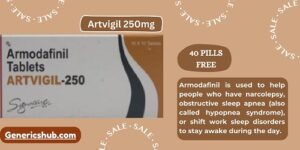5 Lies Delhi Escortss Tell
Noida Extension has now turn out to be the hub of India’s luxury real property sector with large variety of
Armodafinil tablets, particularly Artvigil 150, have gained significant attention in recent years due to their purported ability to enhance wakefulness and cognitive function. But how exactly do these tablets work? In this comprehensive guide, we delve into the intricate mechanisms behind Armodafinil and provide a detailed explanation of Artvigil 150.
Armodafinil is a medication prescribed primarily to treat sleep disorders such as narcolepsy, obstructive sleep apnea, and shift work sleep disorder. It belongs to a class of drugs known as wakefulness-promoting agents. Artvigil 150 is a brand name for Armodafinil tablets, containing 150 milligrams of the active ingredient.
The exact mechanism of action of Armodafinil is not fully understood, but it is believed to work by affecting certain neurotransmitters in the brain. One of the primary neurotransmitters involved is dopamine, which plays a crucial role in regulating wakefulness and alertness.

Armodafinil is thought to increase the release of dopamine in the brain by blocking the reuptake of dopamine into nerve cells. This leads to an accumulation of dopamine in the synaptic cleft, enhancing its effects on wakefulness and cognition.
In addition to its effects on dopamine, Armodafinil also influences other neurotransmitters such as norepinephrine and serotonin. Norepinephrine is involved in regulating attention and arousal, while serotonin is known to modulate mood and cognitive function.
By modulating the levels of these neurotransmitters, Armodafinil promotes wakefulness, improves cognitive function, and enhances mood. This is why it is often used off-label as a cognitive enhancer by individuals seeking to boost their productivity and focus.
Armodafinil is rapidly absorbed after oral administration, with peak plasma concentrations reached within 2 to 4 hours. Unlike some other stimulants, it has a long half-life, ranging from 10 to 14 hours, which allows for sustained effects throughout the day.
The drug is extensively metabolized in the liver, primarily by the enzyme CYP3A4. The metabolites are then eliminated primarily through the urine, with a small portion excreted in the feces.
Numerous clinical studies have demonstrated the efficacy of Armodafinil in improving wakefulness and cognitive function in patients with sleep disorders. It has been shown to reduce excessive daytime sleepiness, enhance alertness, and improve performance on cognitive tasks.
In addition to its approved indications, Armodafinil has also been investigated for its potential off-label uses, including the treatment of attention deficit hyperactivity disorder (ADHD), depression, and fatigue associated with various medical conditions.

Armodafinil is generally well-tolerated, with most adverse effects being mild to moderate in severity. Common side effects include headache, nausea, dizziness, and insomnia. Serious side effects such as allergic reactions and psychiatric symptoms are rare but can occur.
It is important to use Armodafinil under the supervision of a healthcare professional and to follow the prescribed dosage regimen to minimize the risk of adverse effects.
In conclusion, Armodafinil tablets, including Artvigil 150, are a popular choice for the treatment of sleep disorders and for enhancing wakefulness and cognitive function. By modulating neurotransmitter levels in the brain, Armodafinil promotes alertness, improves cognitive performance, and enhances mood.
Despite its widespread use, it is essential to use Armodafinil responsibly and under medical supervision to ensure safety and efficacy. As with any medication, individual responses may vary, and potential risks should be carefully weighed against the benefits.
Noida Extension has now turn out to be the hub of India’s luxury real property sector with large variety of
Uw gemoedsrust en tevredenheid staan bij ons voorop, dus aarzel niet om contact met ons op te nemen in geval